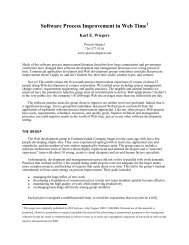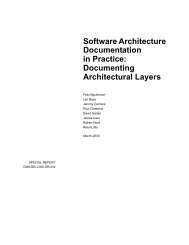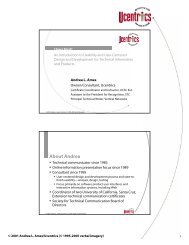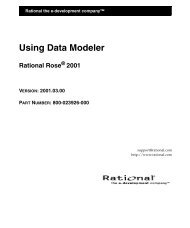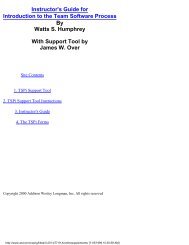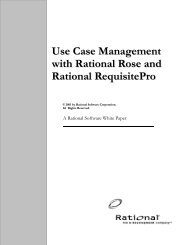RSI - A Structured Approach Use Cases and HCI Design
RSI - A Structured Approach Use Cases and HCI Design
RSI - A Structured Approach Use Cases and HCI Design
Create successful ePaper yourself
Turn your PDF publications into a flip-book with our unique Google optimized e-Paper software.
The <strong>RSI</strong> <strong>Approach</strong> To <strong>HCI</strong> <strong>Design</strong> / <strong>Use</strong> Case Analysis Page 17 of 42<br />
Another sub-classification of services also proves useful: those that are part of the essential<br />
service set, <strong>and</strong> those that are only part of the consolidated service set (the essential set plus<br />
any others). The essential service set is made up of those services use cases that are directly<br />
m<strong>and</strong>ated by the requirement use cases regardless of any interface design decisions. This<br />
distinction is important in analysing the impact in changes to requirements using the<br />
traceability model, <strong>and</strong> in that the essential service use case set provides a clear definition of<br />
the atomic functions the system will implement.<br />
The target audience for service use cases is system architects, designers <strong>and</strong> developers.<br />
Developing the service use case model falls within the remit of the system designer's role.<br />
3.3. Inter-relationships between the models<br />
The following diagram summarises the relationships between the categorisations of use cases<br />
at a high level (the full meta-model for the <strong>RSI</strong> approach is shown in section 3.6.3 of this<br />
document):<br />
::requirement * *<br />
<br />
::interface * *<br />
<br />
::service<br />
* *<br />
W5a - <strong>RSI</strong> LONG PAPER [42 PAGES].doc( Rev: 5) - 03/09/00<br />
::use case<br />
<br />
Requirement use cases provide the starting point for the use case analysis process. They are<br />
refined into service <strong>and</strong> interface use cases necessary to implement those parts of the<br />
requirement it is decided to automate. The inter-relationships between requirement <strong>and</strong><br />
interface/service use cases is shown using «trace» dependencies on a use case traceability<br />
diagram.<br />
Interface use cases use service use cases to gain access to the functional core of the system.<br />
The update/query subdivision of services is used in the following manner:<br />
• queries are used by interface use cases to provide information necessary for the<br />
construction of (user) interface dynamics. For example, in a banking system doubleclicking<br />
on a particular customer in a ‘customers' list-box may cause an associated<br />
‘accounts’ list-box to be refreshed with the chosen customer's accounts. To retrieve this<br />
information, a query use case would be used ('select accounts by customer' in this case).



